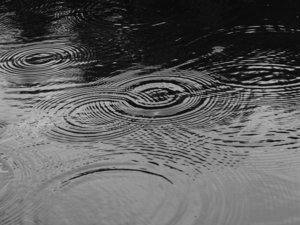If you haven’t read “Just enough light” yet, take a minute and do that.
Arriving at the cottage after dark is always an adventure, particularly if I have forgotten to bring along a flashlight. Without one, I shuffle carefully toward the cottage, mindful of but blind to the many roots, rocks, and bumps that lie there, waiting to trip me. Once I get inside, I grope to my left toward the fireplace mantle, feeling my way along the wall toward the shelf where I know I will find the lanterns and matches. It is not until I get a lantern lit that I can relax a bit and survey my situation.
 Stumbling around and bumping into things is inevitable if we’re in a dark and unfamiliar place. That’s true not only in a physical sense but in virtually every other aspect of our lives. That is frequently the emotional position we are in when faced with an important decision. In fact, the more important the decision or the more ambiguous the options, the more lost and in the dark we may feel. We can’t know all the possibilities ahead or the roots, rocks, and bumps that could trip us.
Stumbling around and bumping into things is inevitable if we’re in a dark and unfamiliar place. That’s true not only in a physical sense but in virtually every other aspect of our lives. That is frequently the emotional position we are in when faced with an important decision. In fact, the more important the decision or the more ambiguous the options, the more lost and in the dark we may feel. We can’t know all the possibilities ahead or the roots, rocks, and bumps that could trip us.
Making decisions.
A friend once told me, “You never just choose between Option A and Option B. You always choose between the consequences of Option A and the consequences of Option B.” At first this sounded like a semantic difference only, but as I paid attention to my daily choices, I saw the wisdom of the statement. Every decision to choose one thing and eliminate something else has consequences, some desirable and some undesirable. Decisions cannot be separated from their consequences.
To complicate the matter, the author Mary Pipher suggests the “Law of 26,” that there are 26 unforeseen consequences lurking behind every consequence we can see. I suspect she made that number up, but the principle is true nonetheless. I will only begin to discover those unforeseen consequences after I make my decision and move in the direction of that decision. Therefore, any decision I make is based on my best guess about the few consequences I can foresee. No matter how long I delay my decision in hopes of learning about all those unforeseen consequences, I cannot avoid them. I will only know them as I make a move and start bumping into them.
 And if that doesn’t complicate the decision-making process enough, each consequence presents me with new choices, each of which has a new set of consequences. Each of those consequences and choices, in turn, has an impact on others and the choices they make in response to me. The ripple effects go on and on.
And if that doesn’t complicate the decision-making process enough, each consequence presents me with new choices, each of which has a new set of consequences. Each of those consequences and choices, in turn, has an impact on others and the choices they make in response to me. The ripple effects go on and on.
So, while it is wise to consider important choices carefully, it comes as no surprise that trying to think too far into the process and trying to anticipate all that might arise is enough to paralyze me. There does come a point at which I must make my best guess with the light I have, and trust that I can deal with the consequences and subsequent choices that follow.
0 Comments until now
Add your Comment!